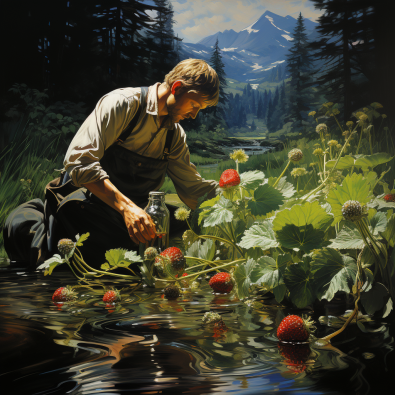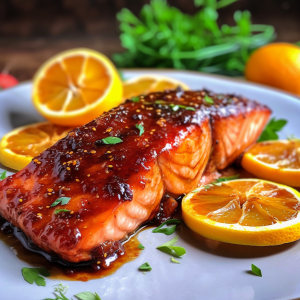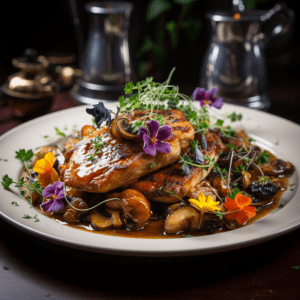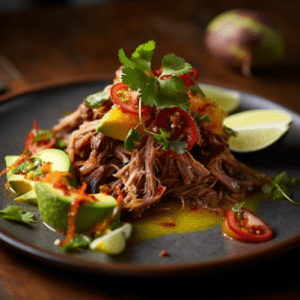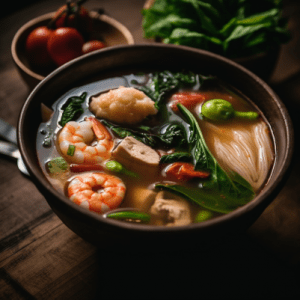Please note that some of the links on this website are affiliate links. I will earn a commission if you decide to make a purchase after clicking through the link. As an Amazon Associate I earn from qualifying purchases.
Welcome to our comprehensive guide to foraging wild strawberries! In this article, we’ve curated 25 tips from experienced chefs to help you discover the best locations, identify the plant, harvest the berries, and even cook with them. Foraging wild strawberries is not only a rewarding experience but also a great way to reconnect with nature and enjoy the health benefits of these delicious berries. So, let’s dive into the world of wild strawberries and discover all the secrets from the pros!

Why Forage Wild Strawberries?
Wild strawberries may be small, but their flavor is mighty. These tiny berries are bursting with sweetness and fragrance that you just can’t find in store-bought strawberries. Beyond taste, there are several compelling reasons to forage wild strawberries.
- Closer to nature: Foraging wild strawberries is a fantastic way to connect with nature. Exploring meadows, fields, and forests in search of these little gems is an adventure, and as you forage, you’ll discover a world of flora and fauna that you might not have noticed before.
- Nutritional benefits: Wild strawberries are an excellent source of vitamins and minerals, including Vitamin C, potassium, and magnesium. They are also rich in antioxidants, which can help protect against disease and aging.
- Environmental impact: By foraging wild strawberries, you’re not only enjoying a delicious treat, but you’re also helping to reduce commercial farming’s environmental impact. Pesticides and fertilizers used in conventional farming practices are harmful to the environment and can contaminate soil and water.
- Thrill of the hunt: There’s an undeniable excitement that comes with foraging. You never know what you’ll find, and discovering a patch of wild strawberries can feel like winning the lottery. The thrill of the hunt makes the fruits of your labor all the more satisfying.
In addition to taste and nutrition, foraging wild strawberries also offers a sense of accomplishment and satisfaction that cannot be replicated. So, grab your basket and get ready to discover the many benefits of foraging wild strawberries.
Identifying Wild Strawberries
Before setting out to forage, it’s important to know how to identify wild strawberries to avoid any unpleasant surprises. Here are some characteristics to look for:
| Characteristic | Description |
|---|---|
| Leaves | Wild strawberry leaves are usually toothed and have three leaflets |
| Flowers | Wild strawberry flowers are typically white with five petals and a yellow center |
| Berry Clusters | Wild strawberries grow in small clusters and are usually smaller than cultivated strawberries |
It’s important to note that there are also look-alike plants, such as mock strawberries and poison ivy, which can be easily mistaken for wild strawberries. To avoid confusion, make sure to carefully examine the leaves and flowers, as these are key distinguishing features. Remember, when in doubt, don’t eat it!
Best Locations for Wild Strawberries
Wild strawberries can be found in a variety of habitats, but some locations are more promising than others. When looking for wild strawberries, keep an eye out for sunny areas with well-draining soil. Here are some of the best places to search for these sweet treats:
| Location | Description |
|---|---|
| Meadows and Fields | Wild strawberries thrive in open areas with lots of sun. Look for them in meadows and fields, especially near the edges. |
| Forests and Woodlands | You can also find wild strawberries in wooded areas, particularly near the edges where there is more light. Look for them growing on the forest floor. |
| Hillsides and Slopes | If you’re hiking or exploring a hilly area, keep an eye out for wild strawberries growing on south-facing slopes. These areas tend to get more sun and can be prime locations for berry-hunting. |
| Coastal Regions | Wild strawberries also grow in coastal regions, particularly on sand dunes. Look for them on the sunny, well-draining slopes of these areas. |
Remember that it’s important to be respectful of the environment when foraging for wild strawberries. Only pick a small percentage of the berries in any given area, leaving plenty for other foragers and wildlife. Also be mindful of any protected or endangered species in the area and avoid disturbing their habitats.
Tools for Foraging Wild Strawberries
When it comes to foraging wild strawberries, having the proper tools and equipment can make all the difference. Not only will they aid in the harvesting process, but they can also keep you safe and ensure a fun and rewarding experience.
Here are some essential tools and equipment to consider:
| Tool/Equipment | Description |
|---|---|
| Basket or container | For collecting and transporting the berries |
| Knife or scissors | To cut the stems without damaging the berries or the plant |
| Gloves | To protect your hands from thorns, poison ivy, or other hazards |
| Long-sleeved shirt and pants | To avoid scratches, insect bites, or exposure to the sun |
| Water bottle and snacks | To stay hydrated and energized during the foraging trip |
It’s also helpful to bring a field guide or a smartphone app that can help you identify wild strawberries and other plants in the area. Make sure to research the specific tools and equipment that are recommended for your region, as different locations may have different requirements.
Harvesting Wild Strawberries
Now that you have found your perfect foraging spot and have your equipment ready, it’s time to start harvesting those delicious wild strawberries. Remember, these berries are delicate and need to be handled with care to avoid bruising or damaging them.
Choosing the Right Berries
When selecting berries, look for firm, plump ones with bright red color. Avoid any berries that are mushy, discolored, or have signs of insect damage. It’s also important to leave some berries behind to ensure that the plant can continue to thrive and produce future harvests.
Proper Picking Techniques
When picking berries, gently grip the stem of the berry and twist it off the plant. It’s important to pick the berries by hand rather than using tools, as this can cause damage to the delicate plants. However, if you must use tools, use scissors or shears to carefully snip the stem.
Preserving Your Harvest
Once you have picked your berries, it’s crucial to store them properly to maintain their freshness and flavor. Keep them refrigerated and use them within a few days for best results. If you have a large harvest, you can also freeze the berries or make them into jams, jellies, or other preserves to enjoy their flavor throughout the year.
With these techniques and tips, you’ll be a pro at harvesting wild strawberries in no time. Remember to always practice responsible foraging and leave some berries behind for future harvests.
Cooking and Baking with Wild Strawberries
Wild strawberries are a versatile and flavorful ingredient that can elevate any dish. Here are some ideas and recipes to get your creative juices flowing:
Simple Ways to Use Wild Strawberries
Wild strawberries can be used in a variety of ways to add a pop of fresh, sweet flavor to your dishes. Try:
- Topping your morning oatmeal or yogurt with fresh wild strawberries.
- Adding them to a green salad with feta cheese and balsamic vinaigrette.
- Serving them alongside grilled chicken or fish for a light and refreshing dinner.
- Blending them into a smoothie with bananas, almond milk, and honey for a nutritious and delicious breakfast or snack.
Recipe: Wild Strawberry Sangria
- 1 bottle of red wine
- 1/4 cup brandy
- 1/4 cup triple sec
- 1/4 cup honey
- 1/2 cup fresh orange juice
- 1/2 cup fresh lemon juice
- 2 cups fresh wild strawberries, sliced
- 1 cup club soda
- In a large pitcher, stir together red wine, brandy, triple sec, honey, orange juice, and lemon juice until honey is dissolved.
- Add sliced wild strawberries and stir to combine.
- Refrigerate for at least 2 hours, or until chilled.
- Before serving, stir in club soda. Pour into glasses with ice and enjoy!
Note: For a non-alcoholic version, substitute grape juice for the red wine and omit the brandy and triple sec.
Health Benefits of Wild Strawberries
Wild strawberries are not only delicious but also packed with nutrients that offer a range of health benefits. Here are some of the reasons why you should consider including wild strawberries in your diet:
| Benefit | Description |
|---|---|
| Antioxidants | Wild strawberries are rich in antioxidants, which can neutralize harmful free radicals and protect against chronic diseases such as cancer and heart disease. |
| Vitamins and minerals | Wild strawberries are a good source of vitamins C and K, as well as potassium, manganese, and folate. These nutrients can support immune function, bone health, and blood pressure regulation. |
| Fiber | Wild strawberries contain fiber, which can aid digestion, regulate blood sugar, and promote feelings of fullness and satiety. |
| Low in calories | Wild strawberries are a low-calorie food, making them an ideal snack or addition to meals for people trying to watch their weight or manage their calorie intake. |
| Anti-inflammatory | Wild strawberries contain compounds that have anti-inflammatory properties, which can help reduce inflammation and associated health conditions like arthritis. |
By incorporating wild strawberries into your diet, you can enjoy a delicious and nutrient-packed food that offers many health benefits. Whether you eat them fresh, bake them into desserts, or use them in savory dishes, wild strawberries are a versatile and nutritious addition to any meal plan.
Precautions and Safety Tips
Foraging wild strawberries can be a fun and rewarding activity, but it’s important to take precautions to ensure your safety and the health of the environment.
Identify the plants with care
Before harvesting wild strawberries, make sure you know how to identify them correctly. Be aware of plants that may resemble wild strawberries, such as poison ivy or poison oak. Avoid harvesting plants that you are unsure of, as they may be poisonous.
Harvest responsibly
When foraging wild strawberries, only take what you need and leave behind enough for the wildlife to sustain itself. Avoid overharvesting as this can lead to a disruption in the ecosystem. Additionally, be mindful of the location where you are harvesting from. Avoid harvesting from polluted areas, such as alongside highways or near industrial sites.
Protect yourself from hazards
Wear appropriate clothing and gloves to protect yourself from possible hazards, such as insect bites or poisonous plants. Use a basket or container to transport the berries safely and avoid damaging them.
Respect local regulations
Check with local authorities and landowners to ensure that you are allowed to forage in the area. Some parks and wildlife areas may have specific regulations or restrictions on foraging, and it’s important to adhere to these rules for everyone’s benefit.
Practice sustainability
Foraging wild strawberries can be a sustainable practice as long as you do it responsibly. Be mindful of your impact on the environment and take steps to minimize it. Only harvest what you need, and avoid damaging the plants or the surrounding habitat.
Frequently Asked Questions (FAQs)
Here are some common questions and answers regarding foraging wild strawberries:
Q: Are all wild strawberries safe to eat?
A: While most wild strawberries are safe to eat, it’s important to ensure you have identified them correctly. Avoid consuming any berries unless you are 100% certain they are wild strawberries and not a poisonous look-alike plant.
Q: When is the best time to forage for wild strawberries?
A: Wild strawberries are typically in season from late spring to early summer, depending on your location. Look for them in areas such as meadows, woods, and fields.
Q: How can I tell if wild strawberries are ripe?
A: Ripe wild strawberries will be bright red and have a sweet fragrance. They should also be soft to the touch but not mushy.
Q: Can I freeze wild strawberries?
A: Yes, you can freeze wild strawberries for later use. Simply wash and dry them, remove the stems, and place them in an airtight container or freezer bag. They will last up to 8 months in the freezer.
Q: How can I incorporate wild strawberries into my cooking and baking?
A: Wild strawberries are versatile and can be used in a variety of dishes, such as salads, smoothies, jams, and desserts. Try substituting them for regular strawberries in your favorite recipes for a unique flavor twist.
Q: What should I bring with me while foraging for wild strawberries?
A: It’s important to bring a few key items with you, such as a basket or container for collecting berries, a knife for cutting stems, and gloves to protect your hands from prickly plants. A field guide or smartphone app for identifying plants can also be helpful.
Q: Is it legal to forage for wild strawberries?
A: Laws regarding foraging can vary by location, so it’s important to research and understand your local laws and regulations. In most cases, foraging small amounts for personal use is allowed, but it’s important to avoid over-harvesting and damaging the ecosystem.
